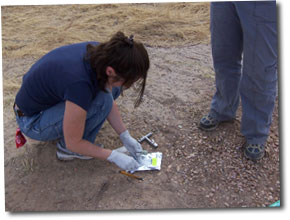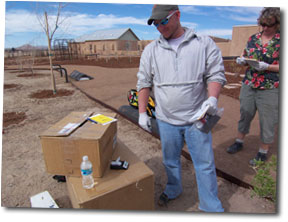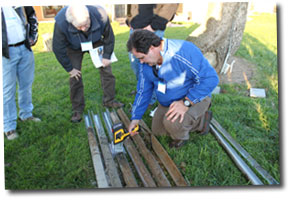
Las Cruces, NM 88011
Phone: 575-532-5535
info@envirofieldschool.com

"Learn Practical Field Methods from the Field Training Experts."
Collection of soil samples for VOC analysis is a critical component
 |
| Students collect in-situ EnCore samples during this field session and prepare them for shipment to the laboratory for extraction and analysis. |
 |
| Students use field analytical balances to weigh soil samples prior to introducing them to tared vials containing methanol. |
of environmental investigations at many sites, ranging from service stations to Superfund sites. Traditional soil sample collection and handling methods are subject to significant sources of negative bias that commonly result in gross underestimation of actual sample concentrations for a wide range of analytes. Given the magnitude of the decisions that are made based on these data, the technical and economic impacts of using these sampling methods can be enormous.
This one-day course focuses on developing an understanding of the physical and chemical properties of soil samples, how samples should be collected and handled to preserve these properties, and how traditional sampling methods can result in significant sources of error in field and lab analyses. In addition, course instructors discuss how and where to collect soil samples to meet project objectives; how to determine how many samples should be collected; ASTM standards on soil sample collection and handling; and how to implement US EPA's Method 5035 for soil sample collection and analysis for VOCs.
Students will be able to immediately apply information provided in this course to field projects where VOCs are of concern and, in doing so, should significantly improve the quality of data generated during soil investigations so sound decisions can be made in a cost-effective manner.
Collection of soil samples for physical and chemical analysis is a
 |
|
In the Complete Soil Sampling Class, students take and examine soil samples using the latest techniques and equipment. |
critical component of environmental investigations at many sites, ranging from service stations to Superfund sites. Traditional soil sample collection and handling methods are subject to significant sources of error and bias that commonly result in compromise of physical characteristics of soils, as wells as gross underestimation of chemical concentrations in soil for a wide range of analytes. Given the magnitude of the decisions that are made based on these data, the technical and economic impacts of using traditional sampling methods can be enormous.
This 2-day course focuses on developing an understanding of the physical and chemical properties of soil samples, how samples should be collected and handled to preserve these properties, how traditional sampling methods can result in significant sources of error in field and lab analyses, and how more up-to-date sampling methods provide much higher confidence in sample analytical results. In addition, course instructors discuss how and where to collect soil samples to meet project objectives; how to determine how many samples should be collected; numerous ASTM standards on soil sample collection and handling; how to implement US EPA's Method 5035B for soil sample collection and analysis for VOCs; how to use X-Ray Fluorescence (XRF) for field sample analysis for metals; and how to use field-portable gas chromatographs for field analysis for VOCs.
Students will be able to immediately apply information provided in this course to field projects where VOCs, metals and other analytes are of concern and, in doing so, should significantly improve the quality of data generated during soil investigations so sound decisions can be made in a cost-effective manner.
Registration Fee for 2015: $1295.00 US per person (plus 8.0% mandatory NM Gross Receipts tax)